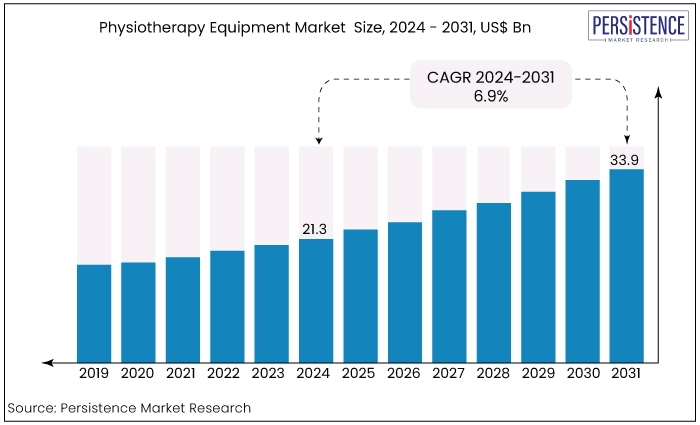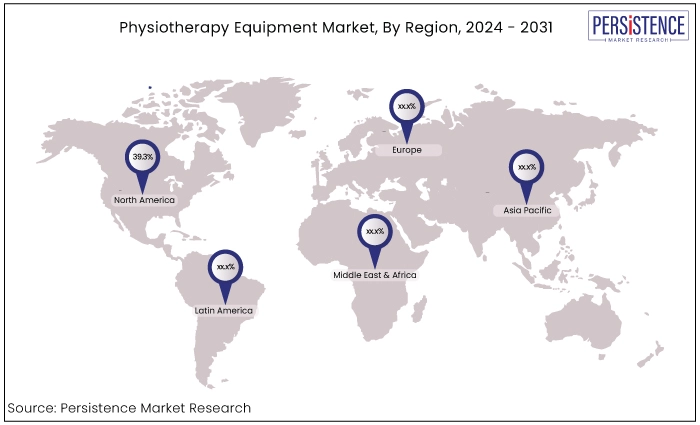Industry: Healthcare
Published Date: August-2024
Format: PPT*, PDF, EXCEL
Delivery Timelines: Contact Sales
Number of Pages: 188
Report ID: PMRREP3209
The global physiotherapy equipment market is expected to increase from US$21.3 Bn in 2024 to US$33.9 Bn by the end of 2031. The market is projected to expand at a CAGR of 6.9% during the forecast period from 2024 to 2031. North America dominates the market share due to its advanced healthcare infrastructure and high awareness levels. Additionally, Asia-Pacific is expected to witness rapid growth, fueled by rising healthcare investments and improving medical facilities.

Key Highlights of the Market
|
Attributes |
Key Insights |
|
Market Size (2024E) |
US$21.3 Bn |
|
Projected Market Value (2031F) |
US$33.9 Bn |
|
Global Market Growth Rate (CAGR 2024 to 2031) |
6.9% |
|
Historical Market Growth Rate (CAGR 2019 to 2023) |
5.8% |
|
Region |
Market Share in 2024 |
|
North America |
39.3% |
The prevalence of chronic diseases and lifestyle-related conditions, such as obesity, diabetes, and arthritis, is high in North America. This increases the demand for effective physiotherapy treatments and related equipment.
North America is estimated to lead the market with significant market share of 39.3%in 2024. Regional market growth is due to growing geriatric population, and increasing cases of accidents and mishaps.
North America, particularly the United States and Canada, boasts a highly developed healthcare system with advanced facilities and technology. This infrastructure supports widespread adoption of the latest physiotherapy equipment and techniques.
There is a high level of awareness and acceptance of physiotherapy and rehabilitation services in North America. Patients and healthcare professionals alike are increasingly recognizing the benefits of physiotherapy, driving market growth.

|
Category |
Market Share in 2024 |
|
Application - Musculoskeletal |
62.3% |
As the global population ages, the prevalence of musculoskeletal disorders like arthritis, osteoporosis, and back pain increases. This demographic shift drives higher demand for musculoskeletal treatments, devices, and therapies. According to WHO estimates from July 2022, more than 1.70 billion people around the world are living with musculoskeletal disorders.
Chronic musculoskeletal conditions, such as degenerative joint diseases and chronic back pain, are common and often require long-term management. This persistent need for treatment and management contributes significantly to revenue. The musculoskeletal segment leads the market and account for 62.3% of the global revenue in 2024.
Ultrasound technology offers real-time imaging, which is crucial for diagnosing and monitoring musculoskeletal conditions and soft tissue injuries. Its non-invasive nature and high resolution make it an attractive choice for physiotherapists, driving increased adoption.
Ultrasound is increasingly used in rehabilitation settings for therapeutic applications, such as deep tissue heating and improving blood flow. This versatility enhances its appeal and drives market growth. There is a rising emphasis on early diagnosis and intervention in physiotherapy. This segment is projected grow substantially during the forecast period from 2024 to 2031.
Ultrasound helps in identifying problems at an early stage, which can lead to more effective treatment plans and improved patient outcomes. The expansion is driven by the rising incidence of lifestyle-related and chronic diseases, along with the expanding use of ultrasound therapy for treating a variety of conditions.
Escalation in geriatric population is a result of increased life expectancy and improved healthcare infrastructure across various countries. It is providing traction to the physiotherapy equipment market, as elderly people are highly prone to mobility disorders.
Besides rapid rise of geriatric population, the global physiotherapy equipment market is also driven by several key factors such as:
The increasing prevalence of chronic diseases such as arthritis, diabetes, and cardiovascular diseases, along with a increasing number of sports injuries and accidents, is driving the demand for physiotherapy services. This, in turn, is fueling the need for advanced physiotherapy equipment.
There is a growing awareness and acceptance of physiotherapy as an essential component of healthcare. Patients and healthcare providers are increasingly recognizing the benefits of physiotherapy in recovery and rehabilitation, leading to higher adoption rates of advanced physiotherapy equipment.
Market expansion has been fueled by several factors during the historical period, including advancements in technology, an increase in the prevalence of chronic diseases and musculoskeletal disorders, and great emphasis on preventive healthcare. the market recorded a 5.8% CAGR during the historical period.
Future growth is expected to be hugely influenced by continued technological innovations. Developments in robotics, AI, virtual reality, and telemedicine are expected to enhance the capabilities and applications of physiotherapy equipment, driving market expansion.
Investments in healthcare infrastructure, particularly in emerging markets, are expanding access to physiotherapy services. The market is expected to record a CAGR of 6.9% during the historical period.
Increasing Prevalence of Chronic Diseases
The increasing prevalence of chronic diseases such as arthritis, diabetes, and cardiovascular conditions drives the need for ongoing physiotherapy. Patients with these conditions often require regular physiotherapy sessions for pain management, rehabilitation, and improved quality of life.
The global aging population is more susceptible to age-related conditions like osteoporosis and joint pain. This demographic shift leads to higher demand for physiotherapy services and equipment tailored to older adults.
Many chronic diseases are more prevalent in older adults. Conditions such as osteoarthritis, osteoporosis, and muscular degeneration are common among the elderly, leading to a high demand for physiotherapy services and equipment specifically designed for this age group.
Physiotherapy aims to enhance functional abilities and improve the quality of life for individuals with chronic diseases. Equipment that aids in improving mobility, strength, and coordination such as gait trainers, resistance bands, and balance boards is essential in these therapeutic intervention.
With rising awareness about the benefits of physiotherapy in managing chronic conditions, patients are more likely to seek out physiotherapy services and equipment. This increased awareness contributes to higher demand for both clinical and home-based physiotherapy solution.
Increasing Emphasis on Preventative Care and Maintaining Physical Wellness
There is a growing emphasis on preventative care and maintaining physical wellness. This trend drives demand for physiotherapy equipment designed to prevent injuries, enhance fitness, and support overall health.
Rising awareness about the benefits of regular physical activity and wellness programs leads to increased adoption of physiotherapy equipment for home use, fitness centers, and corporate wellness programs.
Preventative care also involves managing risk factors associated with chronic diseases. Physiotherapy equipment that aids in managing conditions like hypertension, diabetes, and obesity through targeted exercises and rehabilitation is becoming more sought after.
As many individuals recognize the importance of preventing injuries before they occur, there is a rising demand for physiotherapy equipment that supports injury prevention. Tools such as balance boards, resistance bands, and flexibility trainers are increasingly used to enhance physical conditioning and reduce the risk of injuries.
Shortage of Skilled Professions to Operate the Specialized Equipment
The shortage of skilled professionals capable of operating specialized physiotherapy equipment is a significant factor restraining the growth of the physiotherapy equipment market. Modern physiotherapy equipment, such as robotic-assisted devices, advanced therapeutic ultrasound machines, and high-tech electrotherapy devices, require specialized knowledge and skills to operate effectively.
The complexity of these devices can deter clinics and healthcare facilities from investing in them if they lack trained personnel to use them correctly. This limits the market penetration of advanced physiotherapy equipment.
High Costs of Advanced Equipments
The high cost of purchasing advanced physiotherapy equipment can be a significant barrier for many clinics and healthcare facilities, particularly smaller or independent practice. Advanced equipment also entails ongoing maintenance and operational costs, which can strain the budgets of healthcare providers. This financial burden can deter facilities from upgrading their existing equipment or expanding their services.
Patients may not be fully aware of the benefits of physiotherapy and the availability of advanced treatment options. This lack of awareness can lead to lower demand for physiotherapy services and equipment.
There may be insufficient emphasis on advanced physiotherapy techniques and equipment in the education and training of physiotherapists. This can result in a workforce that is not fully equipped to utilize the latest technologies.
Growing Emphasis on Preventative Care and Maintaining Physical Wellness
There is a growing emphasis on preventative care and maintaining physical wellness. Market players can develop equipment focused on injury prevention, strength training, and overall fitness, catering to health-conscious individuals and fitness enthusiasts.
Creating integrated wellness programs that combine physiotherapy with other health and fitness services can attract a broader audience. These programs can include physical therapy, nutritional guidance, and mental health support
As many individuals recognize the benefits of preventing injuries and managing chronic conditions proactively, there is a rising demand for physiotherapy equipment designed to support preventative rehabilitation. Equipment such as balance trainers, resistance bands, and mobility aids can be marketed as tools for injury prevention and overall physical health maintenance.
There is an increased demand for compact, user-friendly physiotherapy equipment suitable for home use with a increasing trend toward home-based wellness. Products like portable resistance bands, exercise mats, and home rehabilitation devices cater to individuals who prefer to perform their workouts and preventative exercises at homes.
Increase in Technological Advancements
Incorporating robotics and automated systems into physiotherapy can enhance treatment precision and patient outcomes. Equipment like robotic exoskeletons and automated gait training systems are becoming increasingly sophisticated, offering new avenues for development and commercialization.
Advances in wearable devices, such as smart sensors and fitness trackers, enable real-time monitoring of patient progress and biomechanics. Market players can explore opportunities in developing and integrating wearable technologies for personalized and data-driven physiotherapy.
AI and machine learning can be leveraged to analyze patient data, predict treatment outcomes, and optimize therapy plans. Developing AI-driven solutions for physiotherapy can provide more accurate assessments and personalized treatment regimens.
Companies invest heavily in research and development to innovate and improve physiotherapy equipment. This includes integrating advanced technologies like robotics, AI, and telemedicine to enhance functionality and user experience.
Recent Industry Development
|
Attributes |
Details |
|
Forecast Period |
2024 to 2031 |
|
Historical Data Available for |
2019 to 2023 |
|
Market Analysis |
US$ Billion for Value |
|
Key Regions Covered |
|
|
Key Countries Covered |
|
|
Key Market Segments Covered |
|
|
Key Companies Profiled |
|
|
Report Coverage |
|
|
Customization & Pricing |
Available upon request |
By Type
By Application
By End Use
By Region
To know more about delivery timeline for this report Contact Sales

The global physiotherapy equipment market is expected to value at US$21.3 Bn in 2024.
A few of the key market players operating in the market are Enraf-Nonius B.V., EMS Physio Ltd., and DJO Global.
The market is anticipated to expand at a CAGR of 6.9% during the forecast period from 2024 to 2031.
Growing emphasis on preventative care and maintaining physical wellness.
The increasing prevalence of chronic diseases is a key driver for market growth.